Project Management Report: BM522 Camden Service Fundraising Project
VerifiedAdded on 2022/12/14
|13
|2053
|126
Report
AI Summary
This report provides a comprehensive analysis of a project management case study centered around a fundraising concert for the Camden Sickle Cell and Thalassaemia Service Group. The report begins with an executive summary and an introduction that sets the context of the project. It then delves into key project management tools and techniques, including the creation of a network diagram to illustrate project activities and dependencies, a stakeholder analysis to identify and assess the influence of various stakeholders, a job breakdown structure outlining the tasks involved in organizing the music event, a risk assessment to identify and mitigate potential project risks, and an analysis of various project criteria such as quality expectations and acceptance conditions. The report also explores the application of the waterfall model as a suitable project management methodology for this project. Finally, the report concludes with a summary of the findings and a list of references.

Project Management
Paraphrase This Document
Need a fresh take? Get an instant paraphrase of this document with our AI Paraphraser
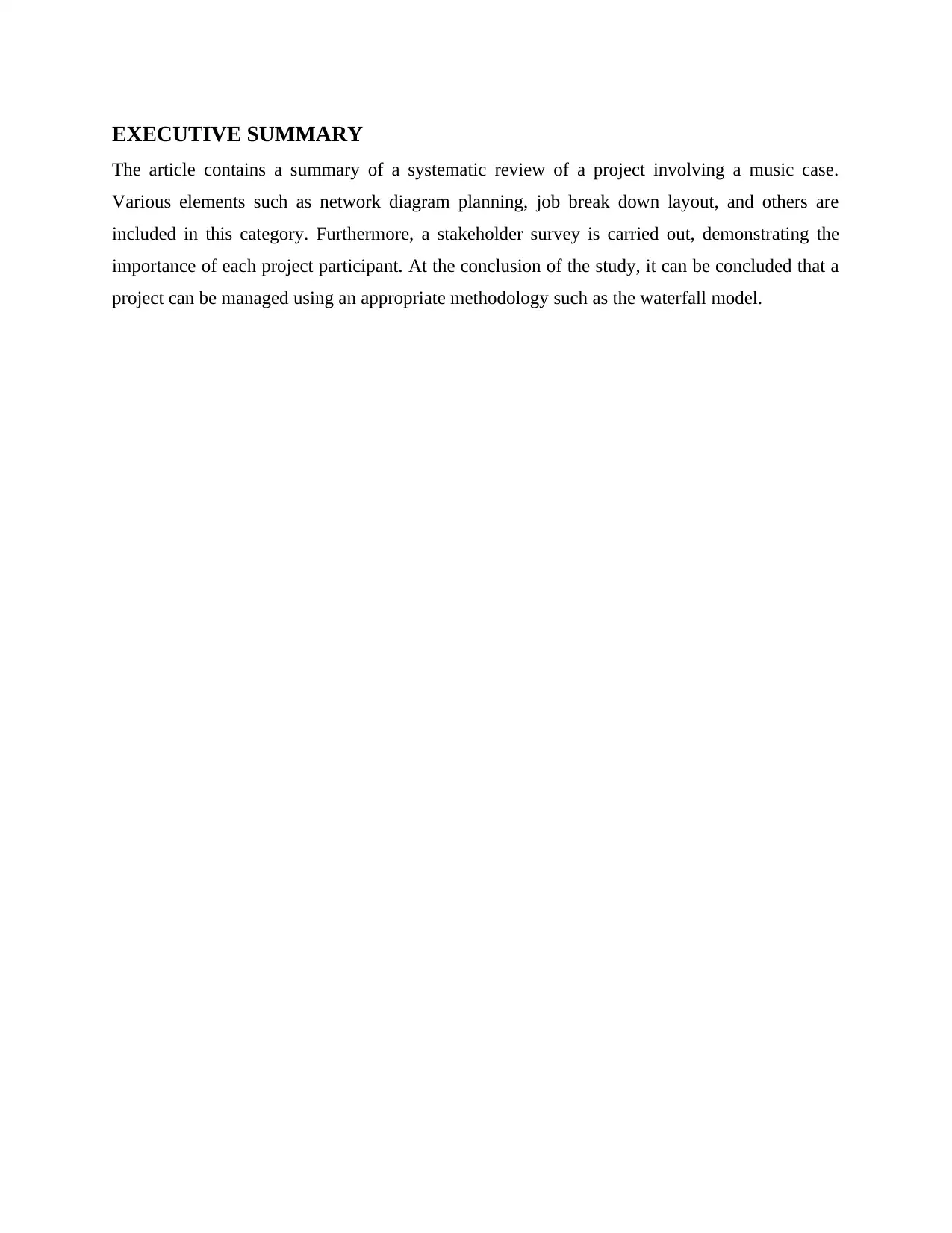
EXECUTIVE SUMMARY
The article contains a summary of a systematic review of a project involving a music case.
Various elements such as network diagram planning, job break down layout, and others are
included in this category. Furthermore, a stakeholder survey is carried out, demonstrating the
importance of each project participant. At the conclusion of the study, it can be concluded that a
project can be managed using an appropriate methodology such as the waterfall model.
The article contains a summary of a systematic review of a project involving a music case.
Various elements such as network diagram planning, job break down layout, and others are
included in this category. Furthermore, a stakeholder survey is carried out, demonstrating the
importance of each project participant. At the conclusion of the study, it can be concluded that a
project can be managed using an appropriate methodology such as the waterfall model.
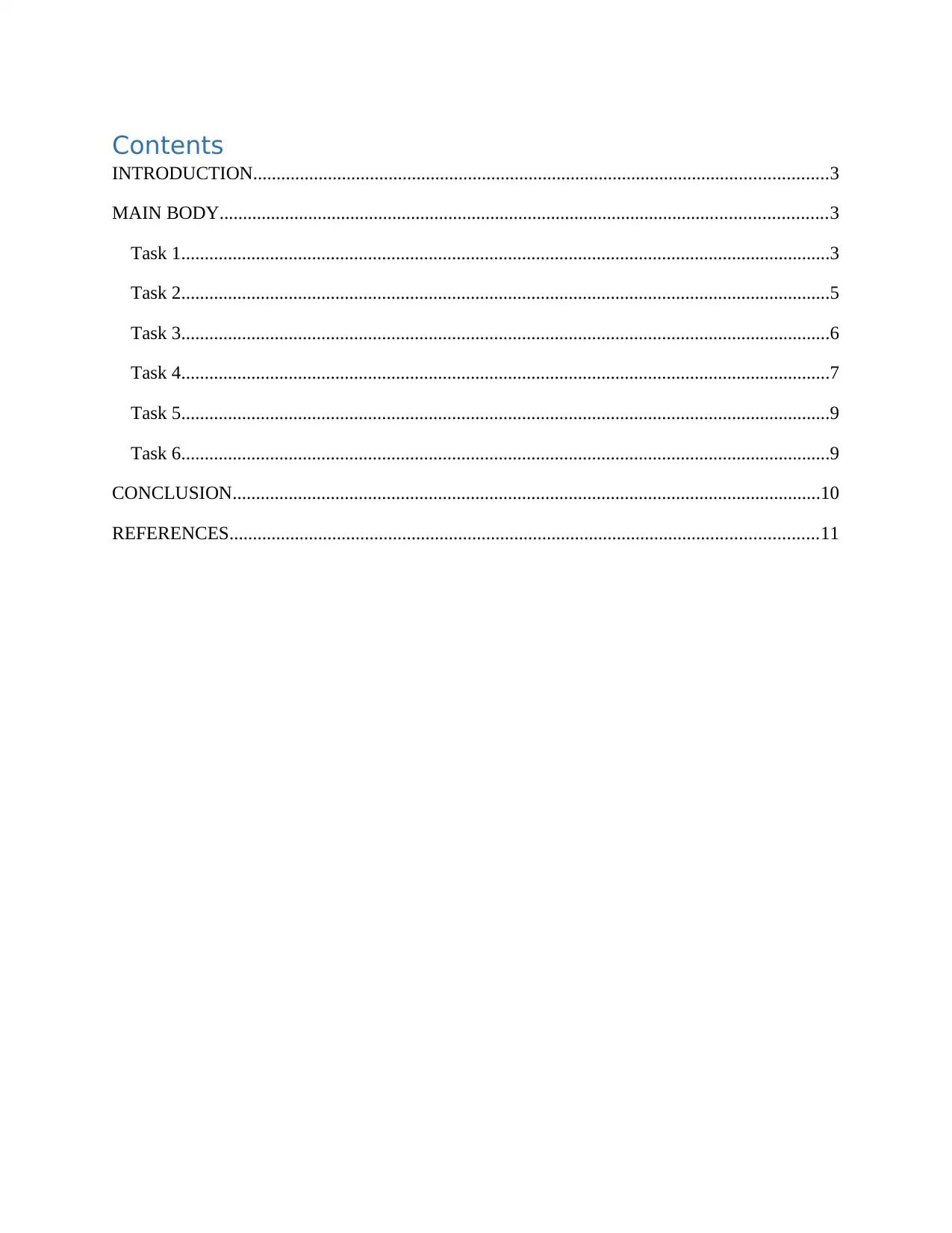
Contents
INTRODUCTION...........................................................................................................................3
MAIN BODY..................................................................................................................................3
Task 1...........................................................................................................................................3
Task 2...........................................................................................................................................5
Task 3...........................................................................................................................................6
Task 4...........................................................................................................................................7
Task 5...........................................................................................................................................9
Task 6...........................................................................................................................................9
CONCLUSION..............................................................................................................................10
REFERENCES..............................................................................................................................11
INTRODUCTION...........................................................................................................................3
MAIN BODY..................................................................................................................................3
Task 1...........................................................................................................................................3
Task 2...........................................................................................................................................5
Task 3...........................................................................................................................................6
Task 4...........................................................................................................................................7
Task 5...........................................................................................................................................9
Task 6...........................................................................................................................................9
CONCLUSION..............................................................................................................................10
REFERENCES..............................................................................................................................11
⊘ This is a preview!⊘
Do you want full access?
Subscribe today to unlock all pages.

Trusted by 1+ million students worldwide
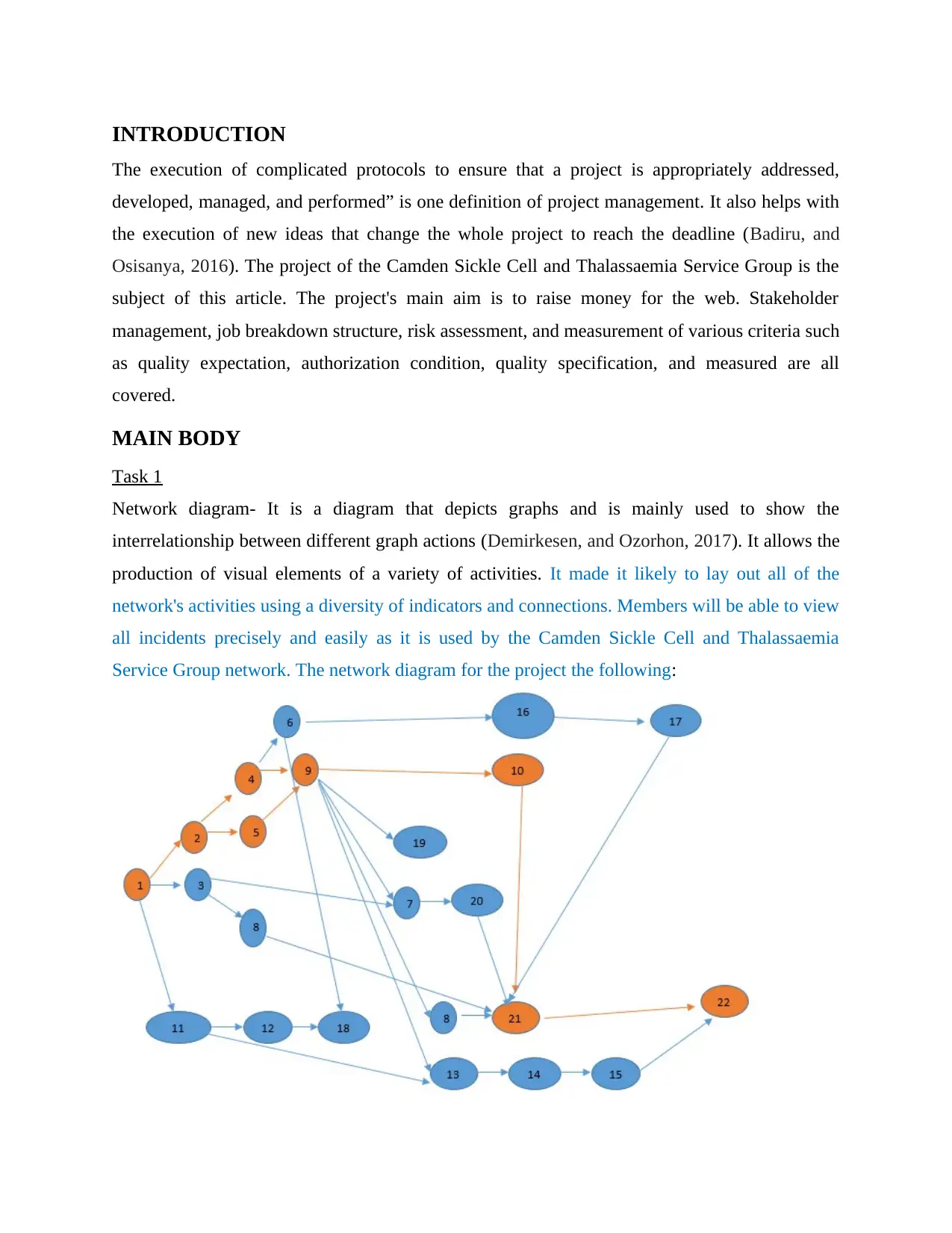
INTRODUCTION
The execution of complicated protocols to ensure that a project is appropriately addressed,
developed, managed, and performed” is one definition of project management. It also helps with
the execution of new ideas that change the whole project to reach the deadline (Badiru, and
Osisanya, 2016). The project of the Camden Sickle Cell and Thalassaemia Service Group is the
subject of this article. The project's main aim is to raise money for the web. Stakeholder
management, job breakdown structure, risk assessment, and measurement of various criteria such
as quality expectation, authorization condition, quality specification, and measured are all
covered.
MAIN BODY
Task 1
Network diagram- It is a diagram that depicts graphs and is mainly used to show the
interrelationship between different graph actions (Demirkesen, and Ozorhon, 2017). It allows the
production of visual elements of a variety of activities. It made it likely to lay out all of the
network's activities using a diversity of indicators and connections. Members will be able to view
all incidents precisely and easily as it is used by the Camden Sickle Cell and Thalassaemia
Service Group network. The network diagram for the project the following:
The execution of complicated protocols to ensure that a project is appropriately addressed,
developed, managed, and performed” is one definition of project management. It also helps with
the execution of new ideas that change the whole project to reach the deadline (Badiru, and
Osisanya, 2016). The project of the Camden Sickle Cell and Thalassaemia Service Group is the
subject of this article. The project's main aim is to raise money for the web. Stakeholder
management, job breakdown structure, risk assessment, and measurement of various criteria such
as quality expectation, authorization condition, quality specification, and measured are all
covered.
MAIN BODY
Task 1
Network diagram- It is a diagram that depicts graphs and is mainly used to show the
interrelationship between different graph actions (Demirkesen, and Ozorhon, 2017). It allows the
production of visual elements of a variety of activities. It made it likely to lay out all of the
network's activities using a diversity of indicators and connections. Members will be able to view
all incidents precisely and easily as it is used by the Camden Sickle Cell and Thalassaemia
Service Group network. The network diagram for the project the following:
Paraphrase This Document
Need a fresh take? Get an instant paraphrase of this document with our AI Paraphraser
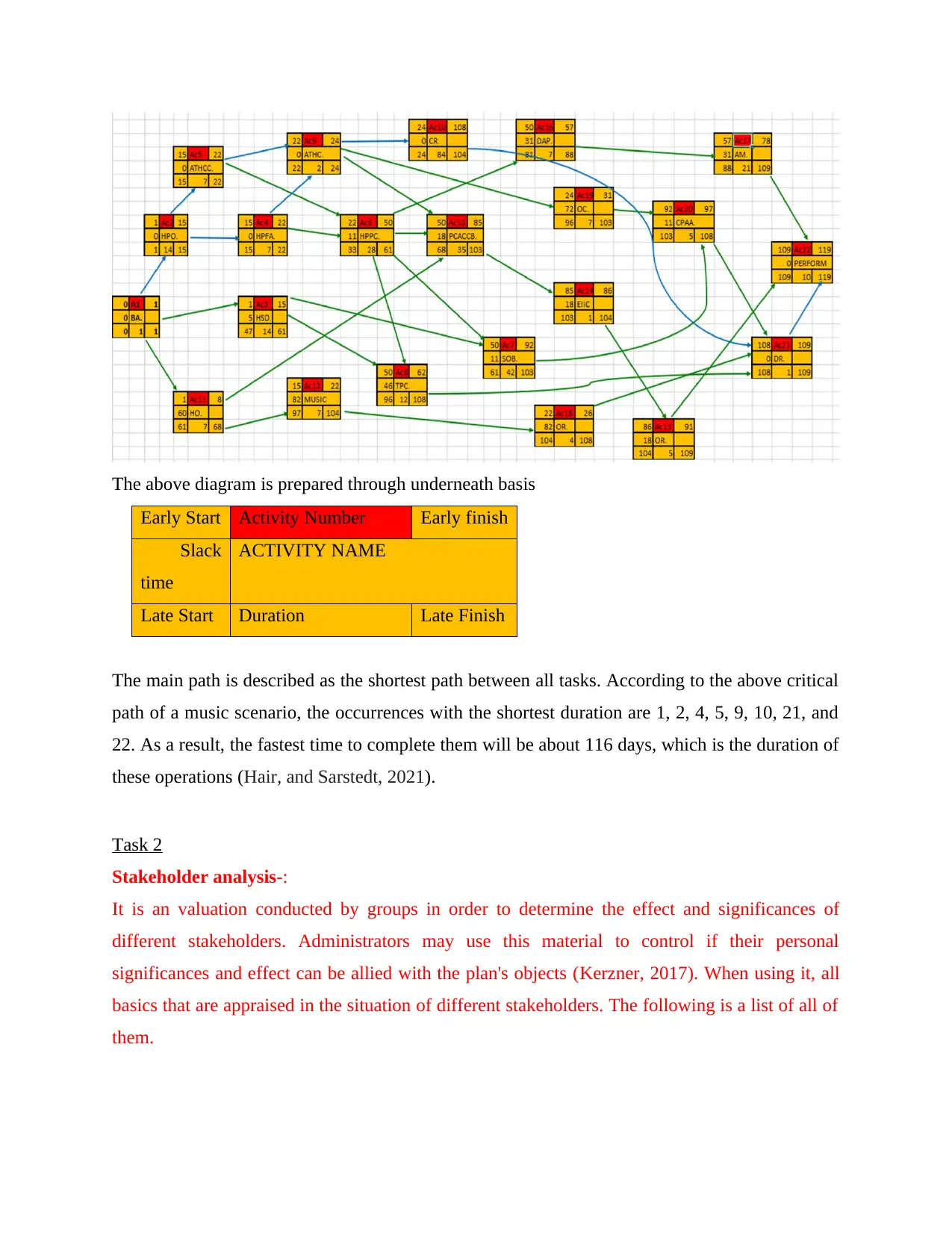
The above diagram is prepared through underneath basis
Early Start Activity Number Early finish
Slack
time
ACTIVITY NAME
Late Start Duration Late Finish
The main path is described as the shortest path between all tasks. According to the above critical
path of a music scenario, the occurrences with the shortest duration are 1, 2, 4, 5, 9, 10, 21, and
22. As a result, the fastest time to complete them will be about 116 days, which is the duration of
these operations (Hair, and Sarstedt, 2021).
Task 2
Stakeholder analysis-:
It is an valuation conducted by groups in order to determine the effect and significances of
different stakeholders. Administrators may use this material to control if their personal
significances and effect can be allied with the plan's objects (Kerzner, 2017). When using it, all
basics that are appraised in the situation of different stakeholders. The following is a list of all of
them.
Early Start Activity Number Early finish
Slack
time
ACTIVITY NAME
Late Start Duration Late Finish
The main path is described as the shortest path between all tasks. According to the above critical
path of a music scenario, the occurrences with the shortest duration are 1, 2, 4, 5, 9, 10, 21, and
22. As a result, the fastest time to complete them will be about 116 days, which is the duration of
these operations (Hair, and Sarstedt, 2021).
Task 2
Stakeholder analysis-:
It is an valuation conducted by groups in order to determine the effect and significances of
different stakeholders. Administrators may use this material to control if their personal
significances and effect can be allied with the plan's objects (Kerzner, 2017). When using it, all
basics that are appraised in the situation of different stakeholders. The following is a list of all of
them.
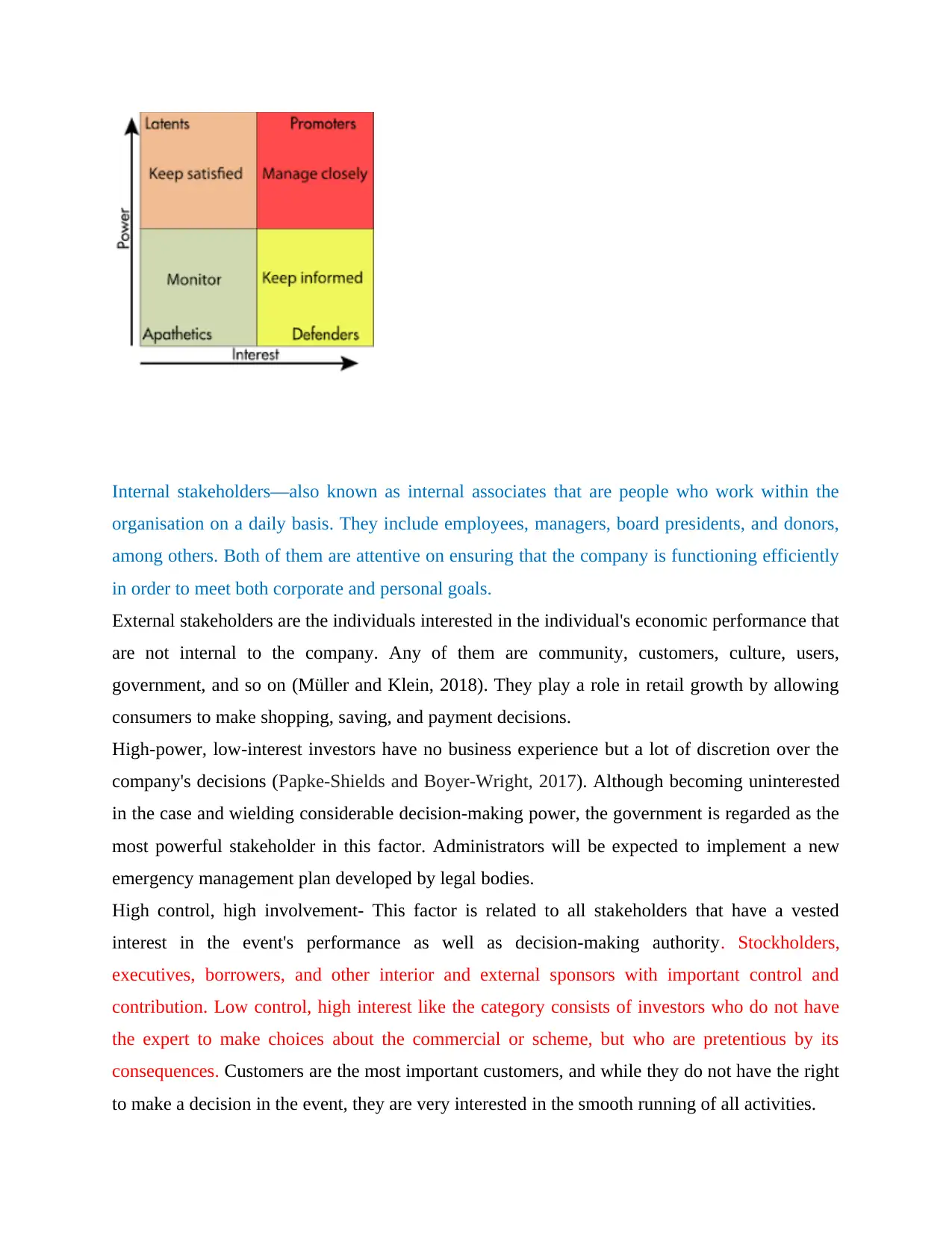
Internal stakeholders—also known as internal associates that are people who work within the
organisation on a daily basis. They include employees, managers, board presidents, and donors,
among others. Both of them are attentive on ensuring that the company is functioning efficiently
in order to meet both corporate and personal goals.
External stakeholders are the individuals interested in the individual's economic performance that
are not internal to the company. Any of them are community, customers, culture, users,
government, and so on (Müller and Klein, 2018). They play a role in retail growth by allowing
consumers to make shopping, saving, and payment decisions.
High-power, low-interest investors have no business experience but a lot of discretion over the
company's decisions (Papke-Shields and Boyer-Wright, 2017). Although becoming uninterested
in the case and wielding considerable decision-making power, the government is regarded as the
most powerful stakeholder in this factor. Administrators will be expected to implement a new
emergency management plan developed by legal bodies.
High control, high involvement- This factor is related to all stakeholders that have a vested
interest in the event's performance as well as decision-making authority. Stockholders,
executives, borrowers, and other interior and external sponsors with important control and
contribution. Low control, high interest like the category consists of investors who do not have
the expert to make choices about the commercial or scheme, but who are pretentious by its
consequences. Customers are the most important customers, and while they do not have the right
to make a decision in the event, they are very interested in the smooth running of all activities.
organisation on a daily basis. They include employees, managers, board presidents, and donors,
among others. Both of them are attentive on ensuring that the company is functioning efficiently
in order to meet both corporate and personal goals.
External stakeholders are the individuals interested in the individual's economic performance that
are not internal to the company. Any of them are community, customers, culture, users,
government, and so on (Müller and Klein, 2018). They play a role in retail growth by allowing
consumers to make shopping, saving, and payment decisions.
High-power, low-interest investors have no business experience but a lot of discretion over the
company's decisions (Papke-Shields and Boyer-Wright, 2017). Although becoming uninterested
in the case and wielding considerable decision-making power, the government is regarded as the
most powerful stakeholder in this factor. Administrators will be expected to implement a new
emergency management plan developed by legal bodies.
High control, high involvement- This factor is related to all stakeholders that have a vested
interest in the event's performance as well as decision-making authority. Stockholders,
executives, borrowers, and other interior and external sponsors with important control and
contribution. Low control, high interest like the category consists of investors who do not have
the expert to make choices about the commercial or scheme, but who are pretentious by its
consequences. Customers are the most important customers, and while they do not have the right
to make a decision in the event, they are very interested in the smooth running of all activities.
⊘ This is a preview!⊘
Do you want full access?
Subscribe today to unlock all pages.

Trusted by 1+ million students worldwide
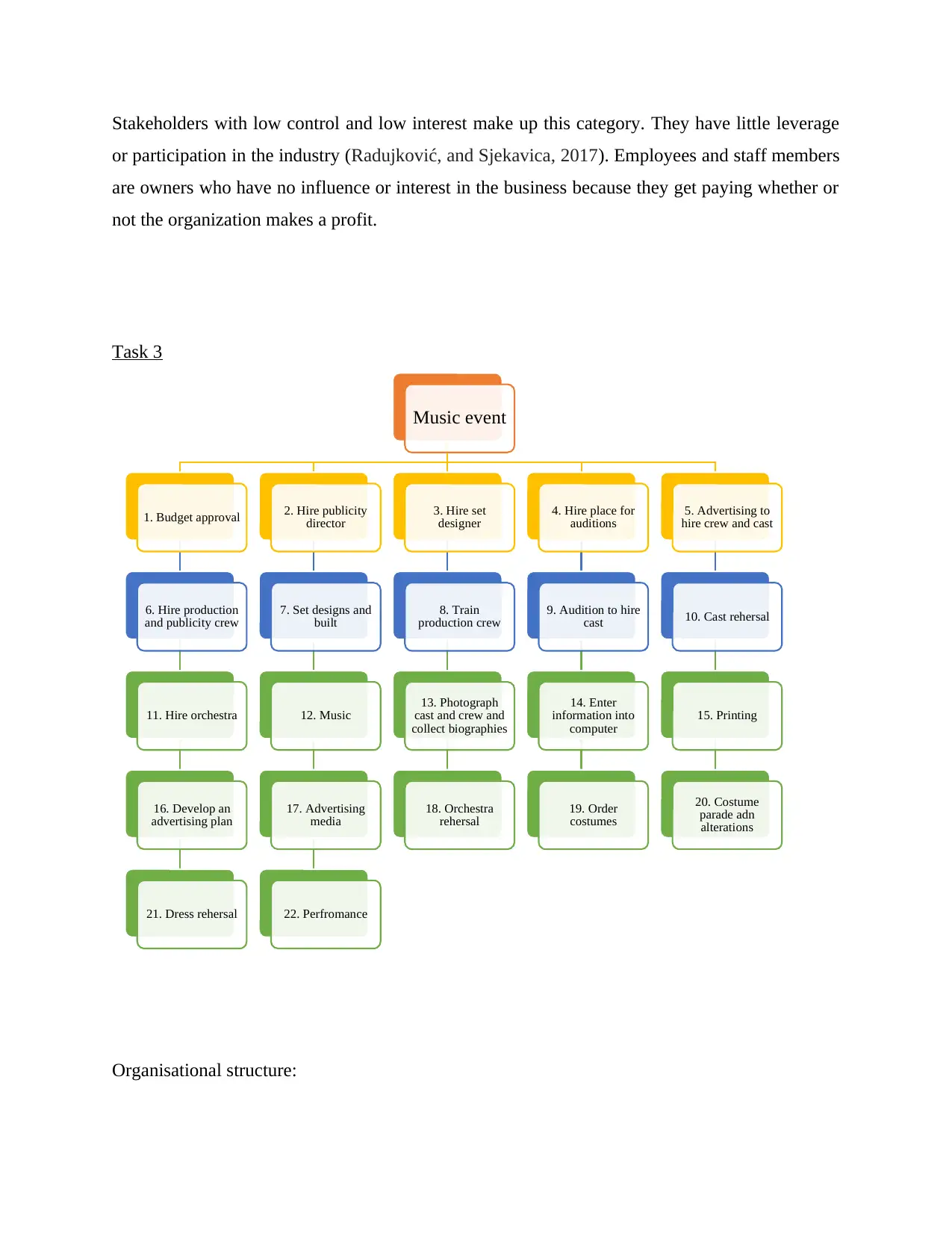
Stakeholders with low control and low interest make up this category. They have little leverage
or participation in the industry (Radujković, and Sjekavica, 2017). Employees and staff members
are owners who have no influence or interest in the business because they get paying whether or
not the organization makes a profit.
Task 3
Organisational structure:
Music event
1. Budget approval
6. Hire production
and publicity crew
11. Hire orchestra
16. Develop an
advertising plan
21. Dress rehersal
2. Hire publicity
director
7. Set designs and
built
12. Music
17. Advertising
media
22. Perfromance
3. Hire set
designer
8. Train
production crew
13. Photograph
cast and crew and
collect biographies
18. Orchestra
rehersal
4. Hire place for
auditions
9. Audition to hire
cast
14. Enter
information into
computer
19. Order
costumes
5. Advertising to
hire crew and cast
10. Cast rehersal
15. Printing
20. Costume
parade adn
alterations
or participation in the industry (Radujković, and Sjekavica, 2017). Employees and staff members
are owners who have no influence or interest in the business because they get paying whether or
not the organization makes a profit.
Task 3
Organisational structure:
Music event
1. Budget approval
6. Hire production
and publicity crew
11. Hire orchestra
16. Develop an
advertising plan
21. Dress rehersal
2. Hire publicity
director
7. Set designs and
built
12. Music
17. Advertising
media
22. Perfromance
3. Hire set
designer
8. Train
production crew
13. Photograph
cast and crew and
collect biographies
18. Orchestra
rehersal
4. Hire place for
auditions
9. Audition to hire
cast
14. Enter
information into
computer
19. Order
costumes
5. Advertising to
hire crew and cast
10. Cast rehersal
15. Printing
20. Costume
parade adn
alterations
Paraphrase This Document
Need a fresh take? Get an instant paraphrase of this document with our AI Paraphraser
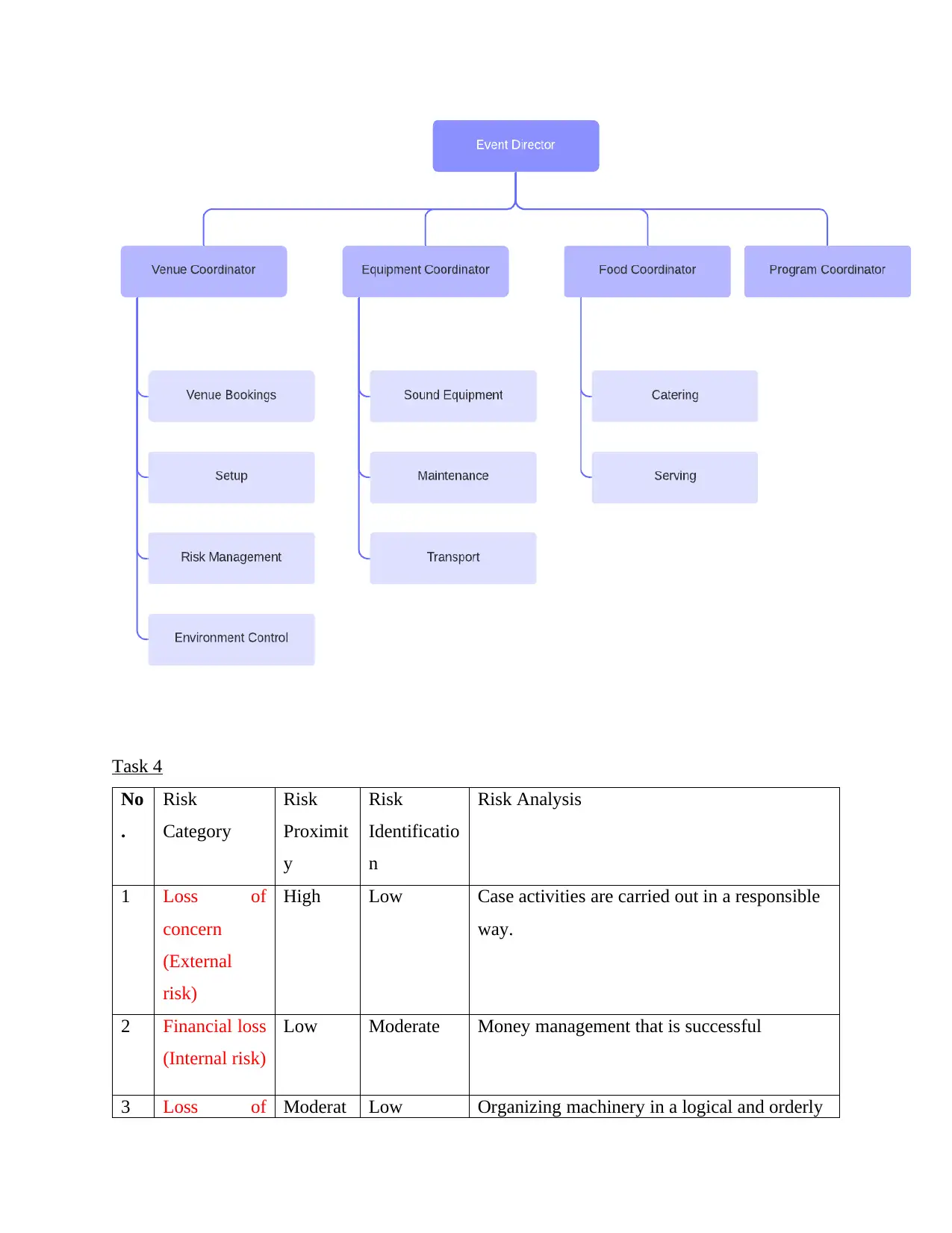
Task 4
No
.
Risk
Category
Risk
Proximit
y
Risk
Identificatio
n
Risk Analysis
1 Loss of
concern
(External
risk)
High Low Case activities are carried out in a responsible
way.
2 Financial loss
(Internal risk)
Low Moderate Money management that is successful
3 Loss of Moderat Low Organizing machinery in a logical and orderly
No
.
Risk
Category
Risk
Proximit
y
Risk
Identificatio
n
Risk Analysis
1 Loss of
concern
(External
risk)
High Low Case activities are carried out in a responsible
way.
2 Financial loss
(Internal risk)
Low Moderate Money management that is successful
3 Loss of Moderat Low Organizing machinery in a logical and orderly
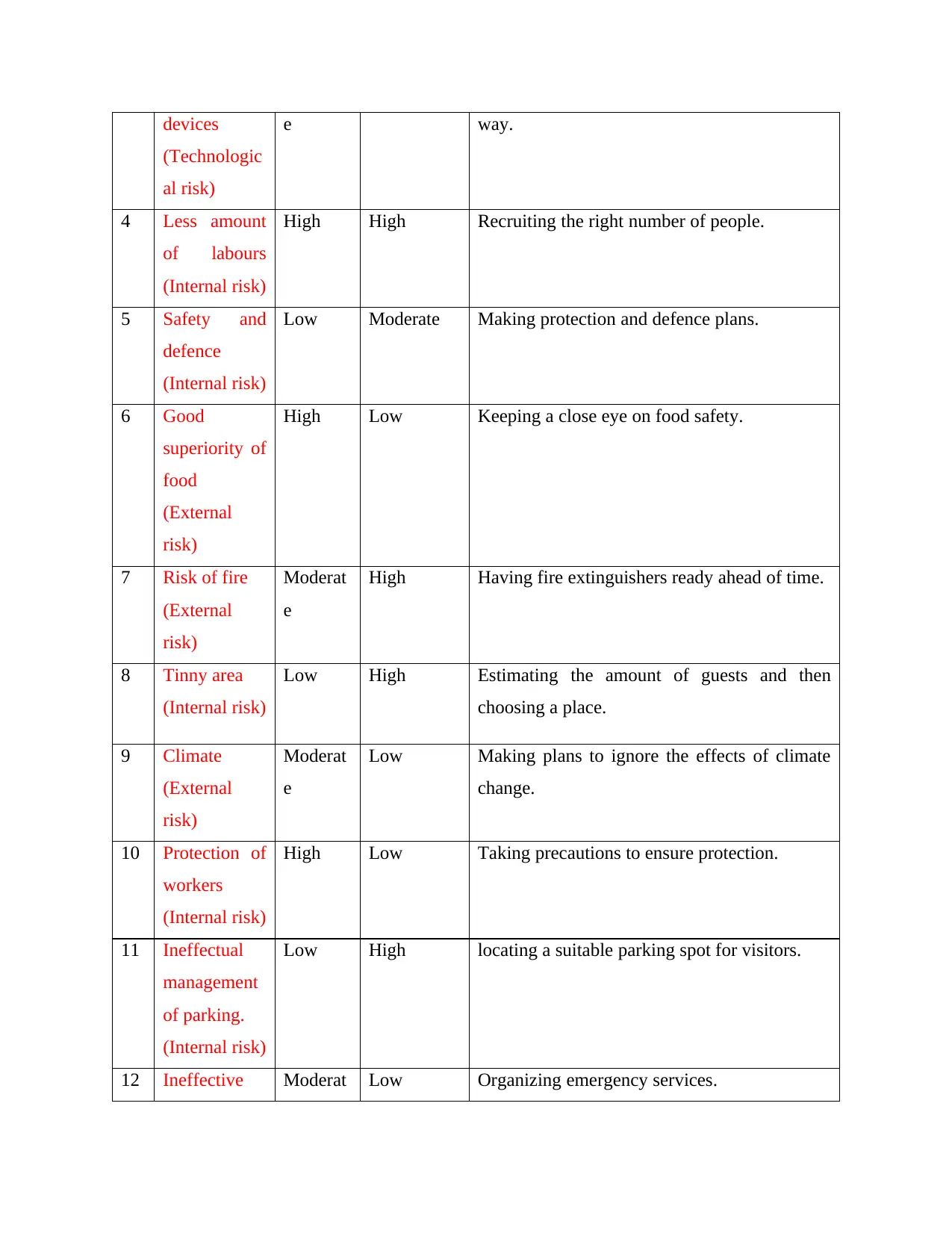
devices
(Technologic
al risk)
e way.
4 Less amount
of labours
(Internal risk)
High High Recruiting the right number of people.
5 Safety and
defence
(Internal risk)
Low Moderate Making protection and defence plans.
6 Good
superiority of
food
(External
risk)
High Low Keeping a close eye on food safety.
7 Risk of fire
(External
risk)
Moderat
e
High Having fire extinguishers ready ahead of time.
8 Tinny area
(Internal risk)
Low High Estimating the amount of guests and then
choosing a place.
9 Climate
(External
risk)
Moderat
e
Low Making plans to ignore the effects of climate
change.
10 Protection of
workers
(Internal risk)
High Low Taking precautions to ensure protection.
11 Ineffectual
management
of parking.
(Internal risk)
Low High locating a suitable parking spot for visitors.
12 Ineffective Moderat Low Organizing emergency services.
(Technologic
al risk)
e way.
4 Less amount
of labours
(Internal risk)
High High Recruiting the right number of people.
5 Safety and
defence
(Internal risk)
Low Moderate Making protection and defence plans.
6 Good
superiority of
food
(External
risk)
High Low Keeping a close eye on food safety.
7 Risk of fire
(External
risk)
Moderat
e
High Having fire extinguishers ready ahead of time.
8 Tinny area
(Internal risk)
Low High Estimating the amount of guests and then
choosing a place.
9 Climate
(External
risk)
Moderat
e
Low Making plans to ignore the effects of climate
change.
10 Protection of
workers
(Internal risk)
High Low Taking precautions to ensure protection.
11 Ineffectual
management
of parking.
(Internal risk)
Low High locating a suitable parking spot for visitors.
12 Ineffective Moderat Low Organizing emergency services.
⊘ This is a preview!⊘
Do you want full access?
Subscribe today to unlock all pages.

Trusted by 1+ million students worldwide
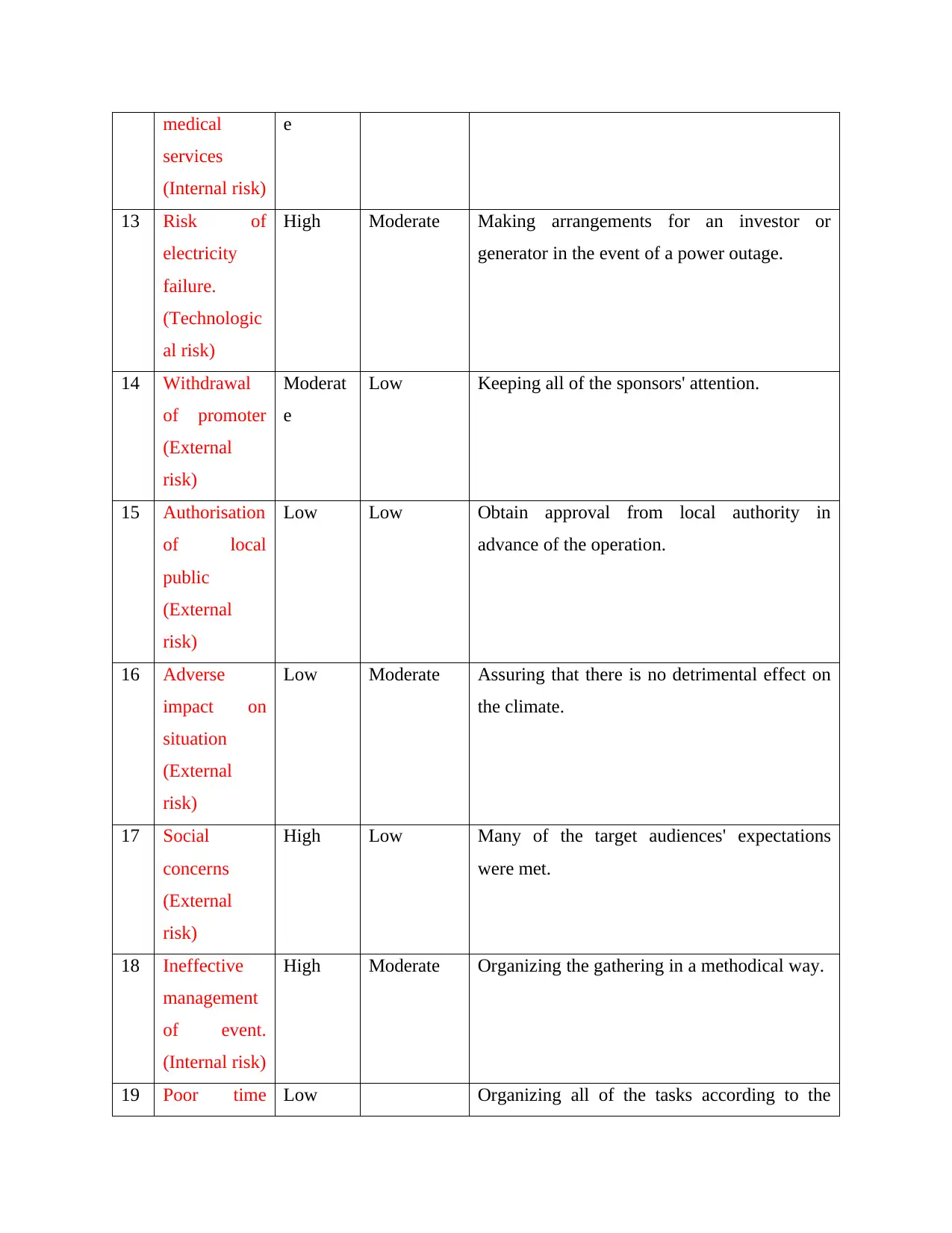
medical
services
(Internal risk)
e
13 Risk of
electricity
failure.
(Technologic
al risk)
High Moderate Making arrangements for an investor or
generator in the event of a power outage.
14 Withdrawal
of promoter
(External
risk)
Moderat
e
Low Keeping all of the sponsors' attention.
15 Authorisation
of local
public
(External
risk)
Low Low Obtain approval from local authority in
advance of the operation.
16 Adverse
impact on
situation
(External
risk)
Low Moderate Assuring that there is no detrimental effect on
the climate.
17 Social
concerns
(External
risk)
High Low Many of the target audiences' expectations
were met.
18 Ineffective
management
of event.
(Internal risk)
High Moderate Organizing the gathering in a methodical way.
19 Poor time Low Organizing all of the tasks according to the
services
(Internal risk)
e
13 Risk of
electricity
failure.
(Technologic
al risk)
High Moderate Making arrangements for an investor or
generator in the event of a power outage.
14 Withdrawal
of promoter
(External
risk)
Moderat
e
Low Keeping all of the sponsors' attention.
15 Authorisation
of local
public
(External
risk)
Low Low Obtain approval from local authority in
advance of the operation.
16 Adverse
impact on
situation
(External
risk)
Low Moderate Assuring that there is no detrimental effect on
the climate.
17 Social
concerns
(External
risk)
High Low Many of the target audiences' expectations
were met.
18 Ineffective
management
of event.
(Internal risk)
High Moderate Organizing the gathering in a methodical way.
19 Poor time Low Organizing all of the tasks according to the
Paraphrase This Document
Need a fresh take? Get an instant paraphrase of this document with our AI Paraphraser
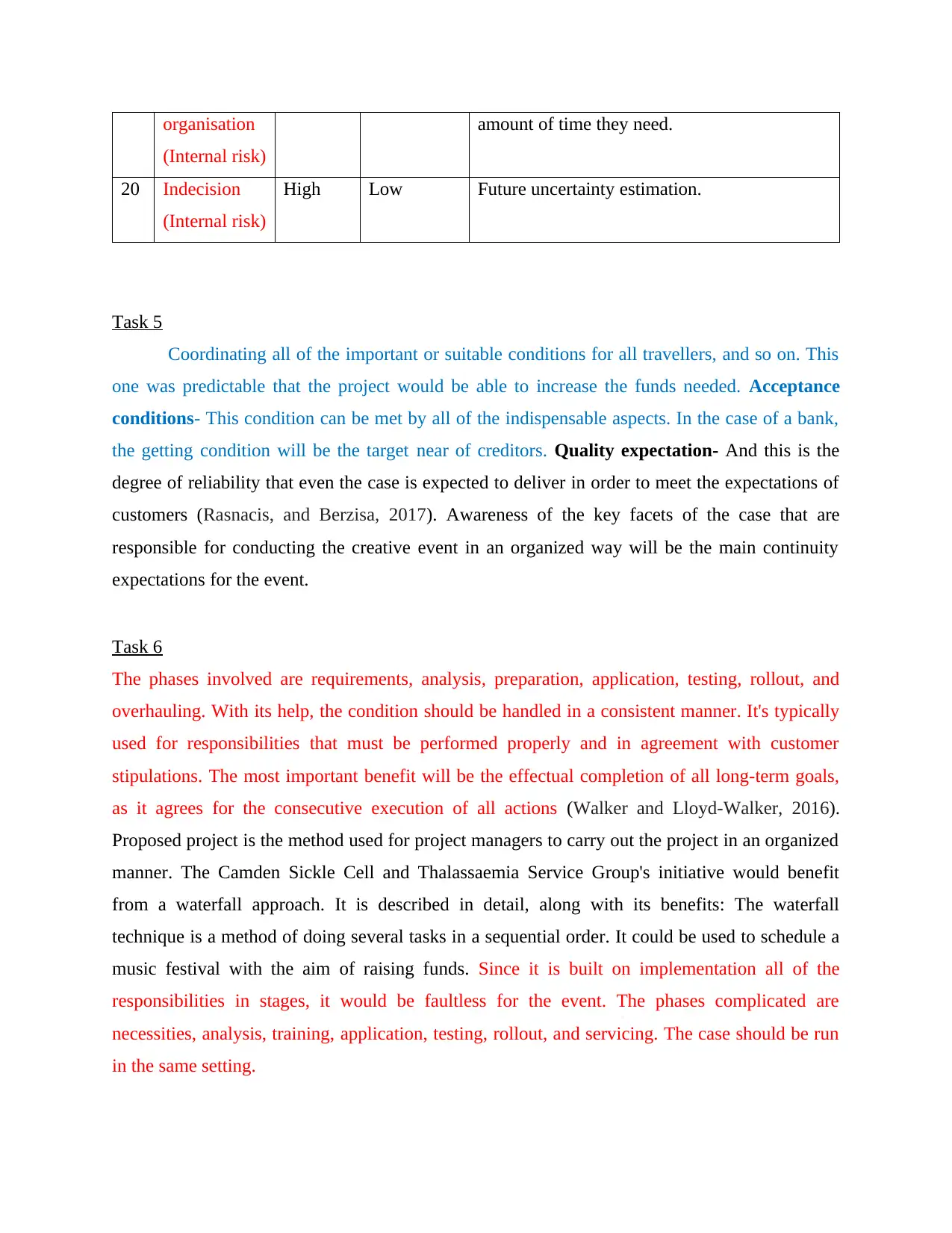
organisation
(Internal risk)
amount of time they need.
20 Indecision
(Internal risk)
High Low Future uncertainty estimation.
Task 5
Coordinating all of the important or suitable conditions for all travellers, and so on. This
one was predictable that the project would be able to increase the funds needed. Acceptance
conditions- This condition can be met by all of the indispensable aspects. In the case of a bank,
the getting condition will be the target near of creditors. Quality expectation- And this is the
degree of reliability that even the case is expected to deliver in order to meet the expectations of
customers (Rasnacis, and Berzisa, 2017). Awareness of the key facets of the case that are
responsible for conducting the creative event in an organized way will be the main continuity
expectations for the event.
Task 6
The phases involved are requirements, analysis, preparation, application, testing, rollout, and
overhauling. With its help, the condition should be handled in a consistent manner. It's typically
used for responsibilities that must be performed properly and in agreement with customer
stipulations. The most important benefit will be the effectual completion of all long-term goals,
as it agrees for the consecutive execution of all actions (Walker and Lloyd-Walker, 2016).
Proposed project is the method used for project managers to carry out the project in an organized
manner. The Camden Sickle Cell and Thalassaemia Service Group's initiative would benefit
from a waterfall approach. It is described in detail, along with its benefits: The waterfall
technique is a method of doing several tasks in a sequential order. It could be used to schedule a
music festival with the aim of raising funds. Since it is built on implementation all of the
responsibilities in stages, it would be faultless for the event. The phases complicated are
necessities, analysis, training, application, testing, rollout, and servicing. The case should be run
in the same setting.
(Internal risk)
amount of time they need.
20 Indecision
(Internal risk)
High Low Future uncertainty estimation.
Task 5
Coordinating all of the important or suitable conditions for all travellers, and so on. This
one was predictable that the project would be able to increase the funds needed. Acceptance
conditions- This condition can be met by all of the indispensable aspects. In the case of a bank,
the getting condition will be the target near of creditors. Quality expectation- And this is the
degree of reliability that even the case is expected to deliver in order to meet the expectations of
customers (Rasnacis, and Berzisa, 2017). Awareness of the key facets of the case that are
responsible for conducting the creative event in an organized way will be the main continuity
expectations for the event.
Task 6
The phases involved are requirements, analysis, preparation, application, testing, rollout, and
overhauling. With its help, the condition should be handled in a consistent manner. It's typically
used for responsibilities that must be performed properly and in agreement with customer
stipulations. The most important benefit will be the effectual completion of all long-term goals,
as it agrees for the consecutive execution of all actions (Walker and Lloyd-Walker, 2016).
Proposed project is the method used for project managers to carry out the project in an organized
manner. The Camden Sickle Cell and Thalassaemia Service Group's initiative would benefit
from a waterfall approach. It is described in detail, along with its benefits: The waterfall
technique is a method of doing several tasks in a sequential order. It could be used to schedule a
music festival with the aim of raising funds. Since it is built on implementation all of the
responsibilities in stages, it would be faultless for the event. The phases complicated are
necessities, analysis, training, application, testing, rollout, and servicing. The case should be run
in the same setting.
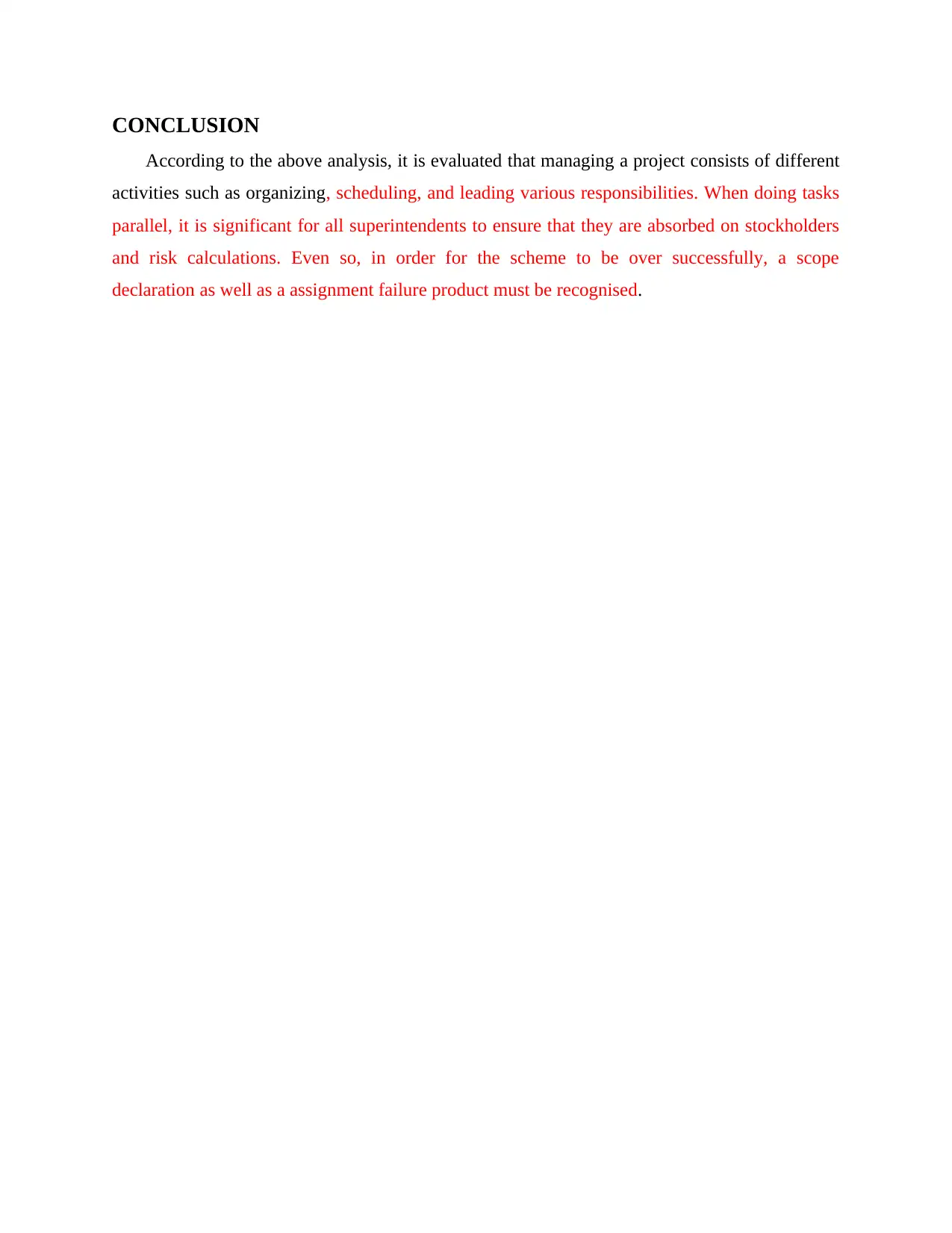
CONCLUSION
According to the above analysis, it is evaluated that managing a project consists of different
activities such as organizing, scheduling, and leading various responsibilities. When doing tasks
parallel, it is significant for all superintendents to ensure that they are absorbed on stockholders
and risk calculations. Even so, in order for the scheme to be over successfully, a scope
declaration as well as a assignment failure product must be recognised.
According to the above analysis, it is evaluated that managing a project consists of different
activities such as organizing, scheduling, and leading various responsibilities. When doing tasks
parallel, it is significant for all superintendents to ensure that they are absorbed on stockholders
and risk calculations. Even so, in order for the scheme to be over successfully, a scope
declaration as well as a assignment failure product must be recognised.
⊘ This is a preview!⊘
Do you want full access?
Subscribe today to unlock all pages.

Trusted by 1+ million students worldwide
1 out of 13
Related Documents
Your All-in-One AI-Powered Toolkit for Academic Success.
+13062052269
info@desklib.com
Available 24*7 on WhatsApp / Email
![[object Object]](/_next/static/media/star-bottom.7253800d.svg)
Unlock your academic potential
Copyright © 2020–2025 A2Z Services. All Rights Reserved. Developed and managed by ZUCOL.





